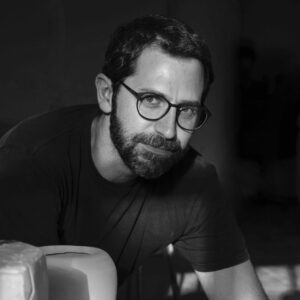
GERARD MAS
Gerard Mas, 1976 yılında Girona (İspanya) Sant Feliu de Guíxols’da doğdu. Barselona’daki Llotja Sanat Okulu’nda okudu. Heykel ve taş oymacılığında uzmanlaştı. 1998-2001. Escola Superior de Conservació i Restauració de Béns Culturals de Catalunya’dan heykel küratörü ve restoratör olarak mezun oldu. Sanatçının eserleri bir çok uluslar arası fuarlarda ve sergilerde yer aldı. Gerard Mas’ın eserleri klasik ile çağdaş dünya arasında gerçekleşen bir diyalog gibidir. Geçmiş ve gelecek, gerçek ve kurgu, ironi ve ciddiyet gibi karşıt öğeler arasındaki diyaloglar heykellerinde en belirgin unsur olarak kendini gösterir. Sanatçının eserlerinde biçimsel kaygılar, kullanılan malzemelerin (mermer, ahşap, reçine) özgün kahramanları olarak rol alır, işte tam olarak bu sebepten kullanılan malzemeyle eserlerde var olan tüm ilkel özellikleri keşfetmek mümkündür. Mas, zihnindekileri görselleştirirken imgeyle ilgilenir, imgenin içeriğinde yer alan mevcut anlayışın bir paradigması olarak tarihsel öneminin içini boşaltır, yeni ve çarpıcı anlamlar yükler.
GERARD MAS
Gerard Mas was born in 1976 in Sant Feliu de Guíxols, Girona (Spain). He studied at the Llotja Art School, in Barcelona, specializing in sculpture and stone carving from 1998 to 2001. He also has a degree in curation and restoration of sculpture from the Escola Superior de Conservació i Restauració de Béns Culturals de Catalunya. Barcelona, 1994-1998. He has exhibited his sculptures in numerous international art fairs and exhibitions. Gerard Mas’ work is precisely a dialogue between the classic world and the contemporary, the past and the present, reality and fiction, the transcendental and the comical which produce these surprising images, due to the contradiction and the irony. Several formal preoccupations have always been present in Mas’ work seen through his choice of materials, which become the authentic protagonists because we discover in them all their primordial characteristics. Mas is interested in the image from the point of view of the visualization, emptying its historical significance, perhaps as a paradigm of the present understanding in which the image replaces the content.